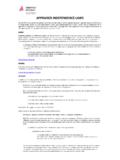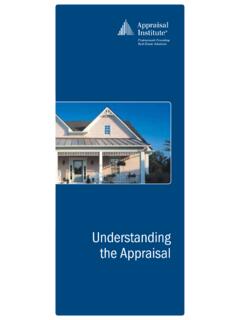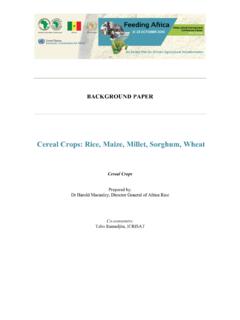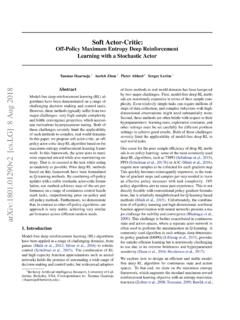Transcription of Analyzing Market Trends - Appraisal Institute
1 Guide Note 12 Analyzing Market TrendsIntroductionSince the value of a property is equal to the present value of all of the future benefits it brings to its owner, Market value is dependent on the expectations of what will happen in the Market in the future. Therefore, a critical step in the development of a Market value opinion is analysis of the Market Trends . The Market Trends study should include what Market participants (buyers, etc.) believe will happen to Market conditions in the future as well as current supply and demand, and anticipated changes to supply and demand. The interaction of these factors profoundly impacts the highest and best use, and in turn the Market value of a property. Analyzing current and anticipated Market conditions is more complicated and more critical when a Market is rapidly changing, either upward or downward. A bubble Market might suddenly turn and decline; a bust Market might suddenly start to improve. To what extent is an appraiser responsible for recognizing changes in Market conditions?
2 What steps must an appraiser take to ensure due diligence is done regarding the analysis of Market Trends ?The Standards of Valuation Practice (SVP), Standards Rule A-4, Application of Methodology states: The valuer must: (a) research and verify data necessary to develop a credible Appraisal , and (b) correctly employ methods and techniques necessary to produce a cred-ible Appraisal . The Uniform Standards of Professional Appraisal Practice (USPAP) include more rules that address these Standards Rule 1-3 states:When necessary for credible assignment results in developing a Market value opinion, an appraiser must:(a) identify and analyze the effect on use and value of existing land use regulations, reasonably probable modifications of such land use regulations, economic supply and demand, the physical adaptability of the real estate, and Market area Trends ; andComment: An appraiser must avoid making an unsupported assumption or premise about Market area Trends , effective age, and remaining life.
3 (b) develop an opinion of the highest and best use of the real estate. Comment: An appraiser must analyze the relevant legal, physical, and economic factors to the extent necessary to support the appraiser s highest and best use conclusion(s). SVP s Standards Rule A-3: Scope of Work requires the valuer to determine the scope of work necessary to develop an Appraisal that is credible given its intended use. USPAP s Scope of Work Rule states that an appraiser must determine and perform the scope of work necessary to develop credible assignment results. Scope of work includes the type and extent of data researched and the type and extent of analyses applied to arrive at opinions and conclusions. Thus, under either the SVP or USPAP, the extent of the analyses of Market conditions and Trends is a scope of work issue. Along with other aspects of scope of work, the extent of these analyses must be determined at the outset of each Standards Rule 1-6 requires the appraiser to:(a) reconcile the quality and quantity of data available and analyzed within the approaches used; and (b) reconcile the applicability of the approaches, methods and techniques used to arrive at the value conclusion(s).
4 GUIDE NOTE 12 Applicable Valuation StandardsFactors That Cause Markets to ChangeReal estate markets are characterized by cycles. Real estate cycles typically involve successive periods of expansion, peak levels of activity, contraction, and troughs. Factors that cause markets to change are distinctly different from symptoms of change. Examples of symptoms of change include changes in vacancy rates (a leading indicator), falling or rising property prices, increases in the frequency of concessions and seller financing, sales prices exceeding listing price, and other conditions symptomatic of larger, more basic problems. Factors that cause markets to change are generally the product of macro-level forces. They influence Market psychology and drive behavior in profound, sometimes dramatic ways. Such causative factors can involve a single defining event or a slower moving series of events that are evolutionary in nature and sometimes not readily apparent to real time observers. Whether they consist of a single defining event or series of related events, these causative factors are indicative of shifts in underlying political and social as well as economic conditions.
5 Factors That Cause Markets to Change (continued)Factors that cause markets to change may be capital (transactional) based or fundamental (space user) based. Examples of capital based factors that cause markets to change include:1. Changes in public policy, particularly related to monetary policy and government spending, taxation, interest rates , the availability of financing and capital formation, length and facilitation of the local entitlement process, and employment Inflationary/deflationary pressures on the regional, national, and global Overabundance of investment capital resulting in increased competition (often too much money chasing too few deals), overly aggressive investment strategies, progressively lax underwriting of fundamental (space user) based factors that cause markets to change include:1. Changes in migration patterns and population shifts which cause overcapacity in some areas and undersupply in Economic shock caused by events such as 9/11, the Lehman bankruptcy, the bust of the early 2000s, the Arab oil embargo of the 1970s, and periodic spikes in the price of oil, all of which caused wide-scale disruption in property markets affecting everything from corporate strategy, personal live/work decisions, and increased cost of property operation to demand for hotel rooms and second Aging population with its increased demand for retirement communities, congregate care facilities and smaller housing Changes in technology such as green buildings, cloud computing, and internet shopping, which affect employment patterns, new industry formations, and new property types ( , server farms, disaster recovery facilities.)
6 5. Natural disasters and industrial accidents, which are usually local or regional in Changes in affluence and income distribution that influence affordability and consumer and discretionary spending Overbuilding and increases in competitive AnalysisMarket analysis is is defined as The study of the supply and demand in a specific area for a specific type of property. 1 While appraisers generally analyze historic data ( comparable sales) in the valuation process, it is important to recognize that the value of a property is dependent on the future benefits that a property will bring to its owner. Future benefits include the rights to use, occupy, and enjoy the property as well as the right to receive income it may produce. Market values are therefore forward-looking. Data used in the valuation process must be adjusted for Market conditions as necessary so the Market value conclusion reflects this forward-looking stance as of the date of value. Market analysis provides the framework for making determinations about Market conditions analysis is a critical step in the Appraisal process.
7 Adequate Market analysis must be completed before highest and best use analysis, and the determination of highest and best use is critical to an Appraisal assignment when Market value is the analysis provides the data input to identify the highest and best use of a property in terms of (1) property use (2) Market support (economic demand) and timing (absorption rates ), and (3) Market participants (probable users and buyers.)21 Appraisal Institute , The Dictionary of Real Estate Appraisal , 6th ed. (Chicago: Appraisal Institute , 2015 ).2 Stephen F. Fanning, Market Analysis for Real Estate: Concepts and Applications in Valuation and Highest and Best Use. (Chicago: Appraisal Institute , 2014.), pp. 6-8 Market Analysis (continued)Most Market analyses can be completed using a six-step process:1. Define the product (property productivity analysis): Identify physical, legal and location attributes that shape productive capabilities and potential Market delineation: Identify the Market for the Demand analysis: Identify characteristics of the most probable user.
8 Analyze demand drivers such as population, income, Supply analysis: Survey and forecast competition. Analyze existing supply, new inventory coming on line in the near future, and proposed Analysis of the Interaction between supply and demand: Determine if marginal demand exists, predict when Market will move out of Forecast subject capture: Analyze Market seventh step, perform financial feasibility analysis of alternative uses and threshold testing, can be added for proposed manner and degree to which these steps are carried out within an Appraisal assignment are scope of work issues. The scope of work for an assignment must be appropriate given the intended use. It is the appraiser s responsibility to determine the scope of work for the assignment. The scope of work must meet or exceed what the appraiser s peers actions would be in the same or a similar assignment, and with the expectations of parties who are regularly intended users for similar appraiser must decline or withdraw from an assignment if the client will not allow the appraiser s scope of work to be adequate for the assignment.
9 The level of Market analysis performed must be appropriate for the assignment and not limited solely because the client wishes to reduce the Appraisal level of analysis can range from simple to highly sophisticated. On a simple level, demand may be inferred from current Market conditions, or rates of change used to develop projections. On the more sophisticated level, an in-depth analysis of forecast (fundamental) demand is performed. Fundamental Market analysis may be useful and necessary when Analyzing or performing an Appraisal of a property for new construction, or when appraising property in a volatile or rapidly changing Market . In terms of real estate products, whether it be apartments, industrial, retail or office properties, fundamental Market analysis answers the questions of when and how much. Competent appraisers continuously interact with buyers, sellers and agents of transaction activity. Ideally, appraisers have frequent and sustained interaction with buyers or lessees in particular.
10 Such interaction allows appraisers to ascertain, analyze, and understand the motivations of Market participants. Appraisers must be familiar with the local Market dynamics and be able to perform trend analysis and/or fundamental Market analysis to the degree necessary for the specific , appraisers are not expected to be prognosticators. Unforeseen events can completely eradicate conclusions that have been based in trend analysis or fundamental Market analysis. A Market value opinion is as of a particular date, and it is an attempt to reflect the anticipations of Market participants as well as Market fundamental Trends and analysis. Events subsequent to the date of value that were not anticipated by Market participants can cause values to change -- in some cases, Sellers are reluctant to sell and realize losses; therefore, there are few sales, at least An increase in the rate of foreclosures, to the point where foreclosures become the predominant An increase in seller concessions, both in terms of frequency and A tightening of credit markets.















